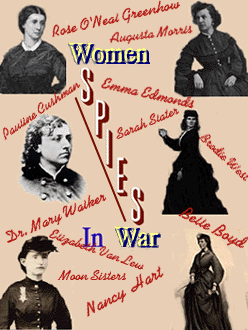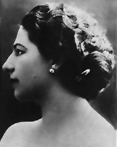 The
gathering of information about one's enemy has been around since prehistoric
times.
The
gathering of information about one's enemy has been around since prehistoric
times.
From clan head to marauding conqueror, leaders needed to know the strengths
and weaknesses of their enemies. Through the ages spying developed into
an art form and no one was better at it than women.
In the early days of the Revolution many Philadelphia women passed key
information along to General Washington at Valley Forge.
Lydia Barrington Darragh spied on the British and informed American
officers. She made several trips from the city to Washington's headquarters,
one in which she concealed an American uniform from the British.
All up and down the east coast women spied for the cause.
Ann Trotter Bailey carried messages across enemy territory in
1774.
Sarah Bradlee Fulton,sometimes called the "mother of the
Boston Tea Party," delivered dispatches through enemy lines.
Emily Geiger rode 50 miles through British and Tory enemy territory
to deliver a message to General Sumter.
During the Civil War Belle Boyd spied for the Confederacy by
carrying important letters and papers across enemy lines. She was imprisoned
in a Union prison for her espionage activities. Ironically, before the
war ended, Belle Boyd married a Captain Harding, a Union naval officer.
 Nancy
Hart served as a Confederate scout, guide and spy, carrying messages
between the Southern Armies. She hung around isolated Federal outposts,
acting as a peddlar,to report their strength, population and vulnerability
to General Jackson. Nancy was twenty years old when she was captured by
the Yankees and jailed in a dilapidated house with guards constantly patrolling
the building. Nancy gained the trust of one of her guards, got his weapon
from him, shot him and escaped. After the war Nancy married Joshua Douglas
and settled in Virgina.
Nancy
Hart served as a Confederate scout, guide and spy, carrying messages
between the Southern Armies. She hung around isolated Federal outposts,
acting as a peddlar,to report their strength, population and vulnerability
to General Jackson. Nancy was twenty years old when she was captured by
the Yankees and jailed in a dilapidated house with guards constantly patrolling
the building. Nancy gained the trust of one of her guards, got his weapon
from him, shot him and escaped. After the war Nancy married Joshua Douglas
and settled in Virgina.
Elizabeth Van Lew asked to be allowed to visit Union prisoners
held by the Confederates in Richmond and began taking them food and medicines.
She realized that many of the prisoners had been marched through Confederate
lines on their way to Richmond and were full of useful information about
Confederate movements. She became a spy for the North for the next four
years, setting up a network of couriers, and devising a code. For her efforts
during the Civil War, Elizabeth Van Lew was made Postmaster of Richmond
by General Grant. After she died, in appreciation of her loyalty to her
country, the people of Massachusetts had a gravestone erected on her grave
which read, "She risked everything that is dear to man - friends,
fortune, comfort, health, life itself, all for the one absorbing desire
of her heart- that slavery might be abolished and the Union preserved."
 The
most famous, and controversial, spy of World War One, though not American,
was Mata Hari - actually Margaretha Geertruida Zelle McLeod - a
Dutch born woman who carried embellishment and exotic stripping to an art
form. But was she ever really a spy? So many myths and legends have surrounded
her past that it's hard to tell reality from mystery. She was an admitted
courtesan, was not as she invented, an exotic dancer from India, and she
was shot by the French as a spy on October 15th 1917. Historians now say
that her principal French accuser was in reality a spy for the Germans
and that her death was as much a needless charade as were her bumbled attempts
at spying. Bettmann Archive Photo
The
most famous, and controversial, spy of World War One, though not American,
was Mata Hari - actually Margaretha Geertruida Zelle McLeod - a
Dutch born woman who carried embellishment and exotic stripping to an art
form. But was she ever really a spy? So many myths and legends have surrounded
her past that it's hard to tell reality from mystery. She was an admitted
courtesan, was not as she invented, an exotic dancer from India, and she
was shot by the French as a spy on October 15th 1917. Historians now say
that her principal French accuser was in reality a spy for the Germans
and that her death was as much a needless charade as were her bumbled attempts
at spying. Bettmann Archive Photo
Another woman who was executed during WWI was Edith Cavell, a
nurse from England who was working in Belguim during the war. Secretly
she worked helping British, French, and Belgian soldiers to escape from
behind the German lines and eventually rejoin their units. She housed as
many as 35 refugees at once in the nursing school where she was the administrator.
When the Germans occupied Belguim they converted Cavell's nursing home
into a Red Cross hospital, and let her continue as Matron under German
supervision. By 1915 she had helped more than 100 British and an additional
100 French and Belgian soldiers. but the Germans grew suspicious and arrested
her in August. Her trial in October lasted only two days and resulted in
a death sentence, in spite of appeals from both the American and Spanish
ambassadors for clemency. On the morning of October 12th , 1915, Edith
Cavell was executed by a German firing squad and buried nearby. Eventually
her body was exhumed and returned to her native soil in Great Britain for
reburial - you will find these words on her statue in St Martins Park -
"'Humanity, Fortitude, Devotion, Sacrifice"
 During
WWII A young woman from Baltimore, Virginia Hall, went to work for
the French as an agent and was so successful that the Nazis began an all
out hunt for her. By the winter of 1941, the Nazis were about to arrest
her, but she escaped on foot over the Pyrenees Mountains into Spain. This
was no easy task for Virgina Hall had lost her leg in a hunting accident
earlier and wore a wooden leg at the time. Not content to rest she trained
as a radio operator and then transferred to America's OSS. In November
1943, disguised as an elderly milk maid, she returned to France and resumed
her espioniage duties.
During
WWII A young woman from Baltimore, Virginia Hall, went to work for
the French as an agent and was so successful that the Nazis began an all
out hunt for her. By the winter of 1941, the Nazis were about to arrest
her, but she escaped on foot over the Pyrenees Mountains into Spain. This
was no easy task for Virgina Hall had lost her leg in a hunting accident
earlier and wore a wooden leg at the time. Not content to rest she trained
as a radio operator and then transferred to America's OSS. In November
1943, disguised as an elderly milk maid, she returned to France and resumed
her espioniage duties.
Virginia was hunted by the Gestapo. They circulated a wanted poster
with the warning, "the woman with the limp is one of the most valuable
Allied agents in France and we must find and destroy her". But her
elaborate disguise fooled the Germans and she painstakingly taught herself
how to walk without a limp. Virginia collected and sent invaluable intelligence
and coordinated air drops in support of D-Day. She also trained and led
maquis resistance groups in guerilla warfare and sabotage.
 After
the war Virginia Hall was awarded America's Distinguished Service Cross
in a simple ceremony...the only American civilian women to receive the
DSC. She was also awarded the the MBE, the Member of the British Empire,
for her courageous efforts. Virginia Hall continued to work for the OSS,
later the CIA, until her retirement in 1966.
After
the war Virginia Hall was awarded America's Distinguished Service Cross
in a simple ceremony...the only American civilian women to receive the
DSC. She was also awarded the the MBE, the Member of the British Empire,
for her courageous efforts. Virginia Hall continued to work for the OSS,
later the CIA, until her retirement in 1966.
Though we began by looking at American women spies, your input on women
spies from all over is most welcome and enthusiastically encouraged. If
you have a true spy story, please submit it for inclusion here.

